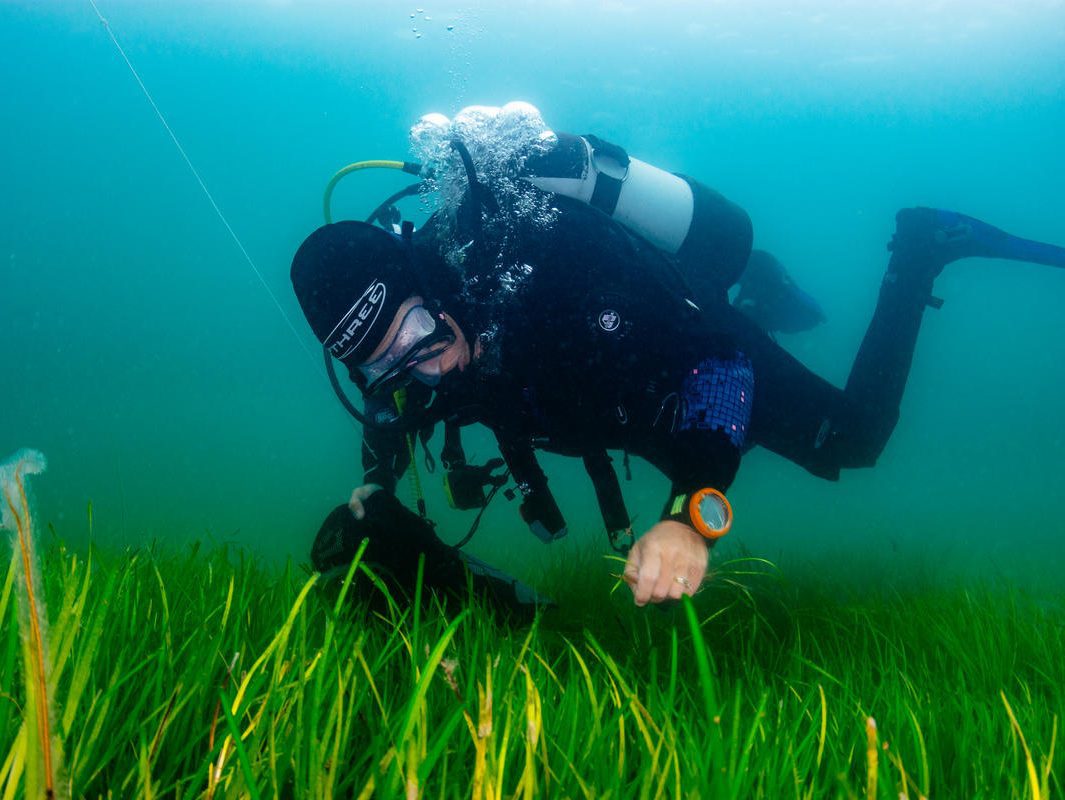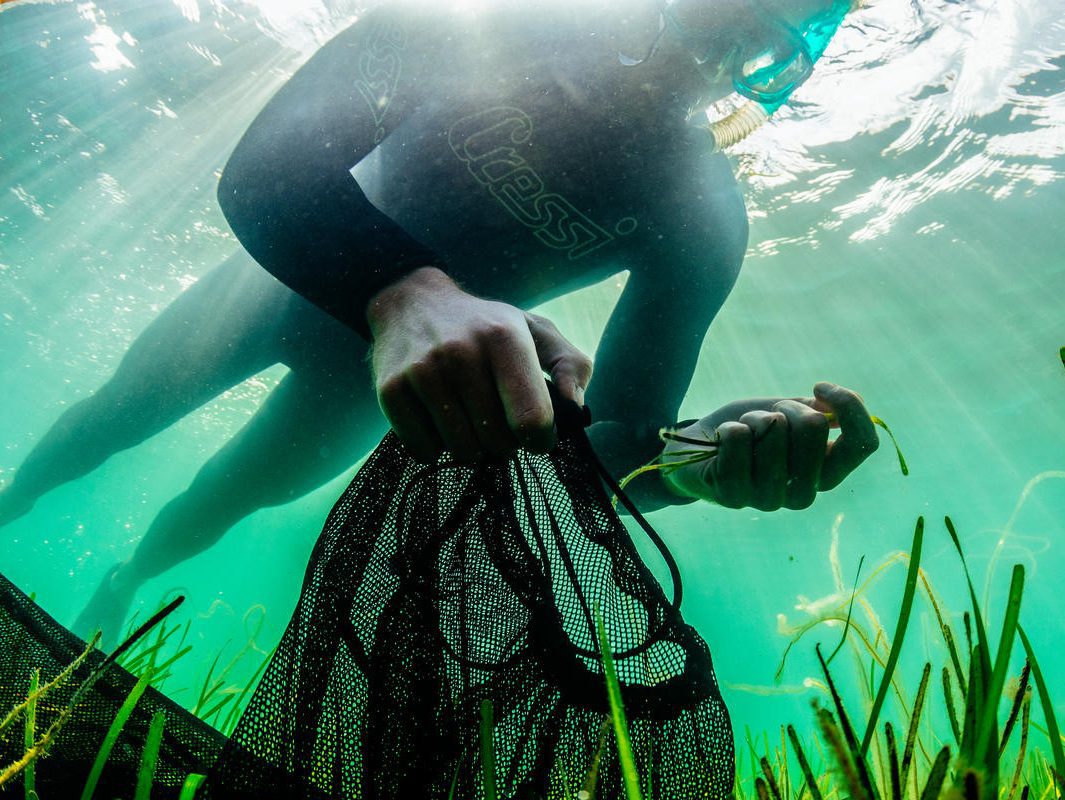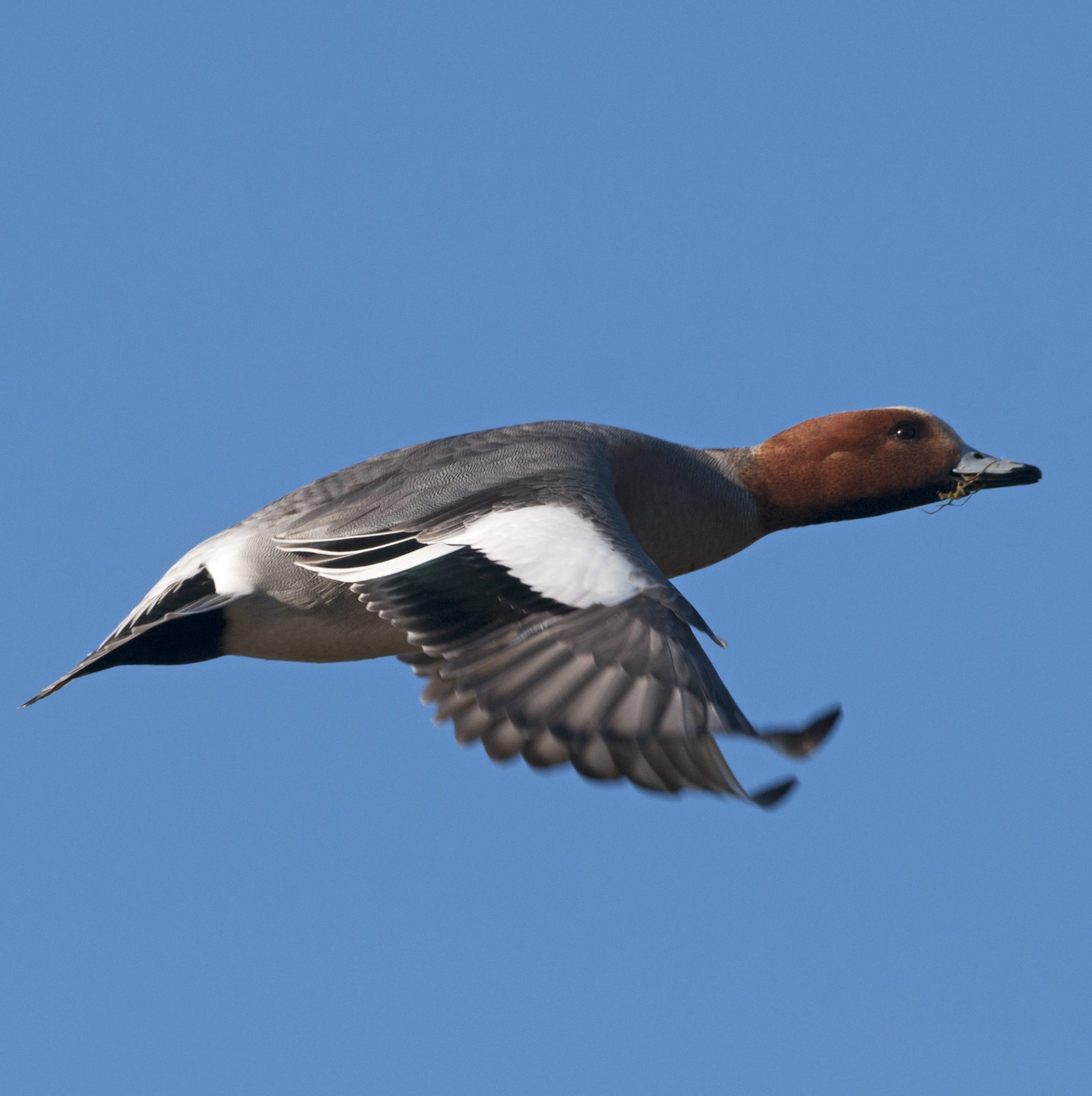On a winter’s day, a small boat pushes off a Pembrokeshire beach, bound on an epic journey. Though the people on board will travel almost no distance at all – never going beyond sight of the shore – their mini-expedition is set to have a massive impact.
Within the next few weeks, that first boat launch marks a critical stage in a unique partnership between WWF, Sky Ocean Rescue and Swansea University. Our aim is to grow meadows on the seabed.
Most of us – if we think about it at all – might imagine that what we see of the flat, muddy bottom of an estuary or tidal bay continues in a shallow, featureless drop under the waves and out into the deep blue. But there are brilliant green exceptions, where the bare sea floor is suddenly thick with thigh-high, grass-like leaves.
This is seagrass, the world’s only flowering plant that is able both to live in seawater and pollinate itself. The harsh currents of our seas mean that meadows of seagrass (also called eelgrass) are confined to sheltered estuaries, bays and lagoons, where the plants put down their roots in soft sediment.
Scientists have only recently discovered that those roots, swollen into rhizomes, are true climate-savers, allowing seagrass to absorb carbon at 35 times the rate of rainforests. The plants lock up about a tenth of the ocean’s carbon under the sea. No wonder seagrass is praised as ‘blue carbon’.
This underwater rainforest is home to amazing wildlife in astonishing abundance. Shoals of tiny shrimp-like crustaceans graze the algae that coats the leaves. Crabs patrol the fronds as anemones and stalked jellyfish filter the water for particles of food. Octopus and cuttlefish shoot past, while marine worms and bivalve molluscs create mini-eruptions, burrowing into the sand.
Fish weave through the waving stems: wrasse, pipefish, gobies and – in a handful of southern meadows – even seahorses. There are also the small fry of species that may one day be caught by humans – among them cod, pollock and plaice.
Most of these were borne as larvae by tidal currents into the meadows. A happy accident, for here their chances of finding food on a daily basis are much higher, their chances of being eaten are reduced, and their chances of putting on weight in their crucial first year are much improved. Our commercial fisheries rely on seagrass meadows to sustain populations destined for the open ocean.
How we gather seagrass seeds

Step 1: Heading out to the meadow
Our seed-collecting teams of volunteers go out at high tide to one of our target seagrass meadows in north Wales, Cornwall, Dorset, the Channel Islands or the Isle of Man. Our goal – to gather one million seeds! The boat is filled with both snorkellers and scuba divers.

Step 2: The seed snorkellers
The first people to jump out of the boat are the snorkelling volunteers. They gather seed-bearing stems from water that may only be a metre deep. It’s easier to collect the stems while they’re under water.

Step 3: at the deep end
Scuba divers plunge off the side of the boat to sink into deeper water further out. There’s still enough sunlight for the seagrass to grow down to about five metres in depth, and sufficient light (just!) for the divers to see what they’re doing. The blades snap off easily in their hands.

Step 4: It’s in the bag
All of the picked stems are immediately dropped into black mesh nets and the nets are brought ashore. A seagrass bed produces trillions of seeds. Not only are there plenty to choose from, but also collection has no harmful impact on the existing meadows. New blades will regrow next season.

Step 5: Landing the catch
The boat has brought the harvest in to shore. The seeds are all of the same species – common eelgrass (Zostera marina). The seeds on each stem look like runner beans in a pod. In the open sea, an air bubble from photosynthesis would burst the membrane, releasing the seeds.

Step 6: preparation in the lab
It wouldn’t be practical to separate the seeds on shore, so they are sent to a laboratory where they are removed from the blades. The seeds are then mixed with sand and put in hessian bags ready for planting out on ropes over a Pembrokeshire seabed.
Seagrass needs saving
These meadows keep on giving. They absorb energy from the waves and trap sediment, reducing erosion; they soak up polluting minerals. But we have shown them little generosity in return. It’s thought that something like nine tenths of Britain’s seagrass meadows have been destroyed, though we can’t be certain of that figure, since mapping underwater habitats up to five metres deep is hard, even with today’s technology.
According to global seagrass expert Dr Richard Unsworth of Swansea University: “The timescales of loss are beyond living memory. Old maps of the coastline show how much has changed – a port here, a sea wall there, reclamation over there.
“And the Industrial Revolution created an environmental footprint that fundamentally changed so much. Our ports were exporting copper, zinc and other heavy metals, and areas like south Wales had some of the world’s biggest coalmines, generating an enormous amount of traffic and pollution.
Four seagrass stars

Spiny seahorse
This fish with a fleshy ‘mane’ down its back drifts through the meadow sucking up shrimps and plankton. At the slightest current, it clings to a stem with its prehensile tail.

Cod
When cod larvae are washed into a seagrass meadow, they may be only two centimetres long. In just a year they reach eight or nine times that length, feeding on tiny crustaceans.

Cuttlefish
A bunch of ‘black grapes’ attached to seagrass are actually the eggs of a cuttlefish. These relatives of squid and octopuses come into the shallows in the spring to lay, then die.

Wigeon
When the tide goes out, ducks, geese and swans graze on exposed seagrass leaves. It’s an especially important source of food in winter for wigeon and brent geese.
IMAGES: © NATUREPL.COM / ALEX MUSTARD / 2020VISION / WWF | © WILD WONDERS OF EUROPE / MAGNUS LUNDGREN / WWF | © GETTY IMAGES
“We’ve seen the cumulative impact of industrial development, poor water quality, and changes in farming practices, such as the run-off of agricultural chemicals. There are places such as the Orwell and Stour estuaries in Suffolk where there were hundreds of hectares of seagrass in the 1970s – there are only a couple of square metres there now.”
Coastal development, and boats with propellers and mooring chains raking the seabed, are major concerns but pollution in its various forms remains the biggest threat to seagrass. Overwhelming quantities of toxic chemicals stunt its growth; cloudy, nutrient-rich water blocks the light and allows less sensitive algae to bloom in its place.
Yet there is still potential for recovery. In south Wales, where industrial pollution completely wiped out seagrass from many coastal bays and inlets generations ago, the coal industry is no more. Seagrass would probably never spread from other distant areas naturally, but we believe it’s possible to replant it in today’s cleaner waters using seeds from parts of Britain where meadows are thriving. A similar approach has been used in North America’s Chesapeake Bay to restore hundreds of hectares of meadows.

© NATUREPL.COM / ALEX MUSTARD / 2020VISION / WWF
Seagrass pilot study success
In 2019, we started working with Richard and his team on the first exploratory steps in the UK. “We did small-scale trials with different methods in one Pembrokeshire bay and they were all very successful,” he explains. “That told us the nutrient levels and other environmental conditions were suitable to support seagrass there.”
We decided to create a two-hectare meadow (about the size of two football pitches) from scratch. Nothing at this scale has ever before been attempted in UK waters.
And comparisons with Chesapeake Bay can only go so far, as Richard explains: “In the US, they were able to cast their seed upon the water from a boat. That couldn’t happen in Britain. For one thing, we have a big population of green shore crabs that will feast on anything and everything they come across. Chucking a load of seeds out would be like feeding the crabs. In UK waters we also have very strong tidal currents. Those seeds could be out in the middle of the Irish Sea within a few minutes.”
Instead, our ingenious scientists are practising a rope trick with growbags. Over the seabed, they will lay out little hessian sacks filled with sand and seeds, tied to ropes at metre intervals. Anchored on the bottom and sealed against predators, the seeds will germinate and shoot through the hessian.
It could take five years or more for this modest meadow to mature and become a haven for a staggering amount of wildlife – an estimated 160,000 fish and 200 million invertebrates in this patch alone. Small beginnings, big results. And the team already has its eyes on other target areas around our coasts.
Patience and cooperation are essential to expanding the project, as Ricardo Zanre, our marine programme manager, emphasises: “We’re doing it in a way that works with local stakeholders – everyone from schools to boaters and fishermen. If we’re going to restore seagrass around the country, then it’s essential that everyone understands the benefits and local people have the opportunity to be involved.”
As Ricardo says: “It’s providing a nature-based solution to some of the toughest problems we’re facing – the climate emergency and the biodiversity crisis in our oceans. It’s critical for a whole range of reasons and it really can help with some of the big issues.” From tiny seeds great meadows may grow, and with them our hopes of a greener, cleaner future.

© NATUREPL.COM / ALEX MUSTARD / WWF
Over to you!
Find out more about our partnership with Sky Ocean Rescue and what we’ve achieved here
• This is an edited version of an article that originally appeared in WWF Action magazine in 2020.
More to explore

Which fish should I eat?
Making environmentally responsible seafood choices is a great way to enjoy a healthy diet and help protect our ocean, but where do you start?

